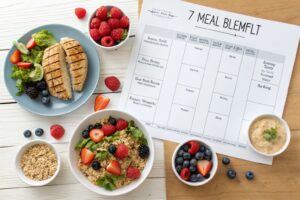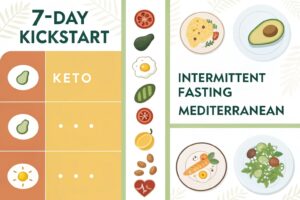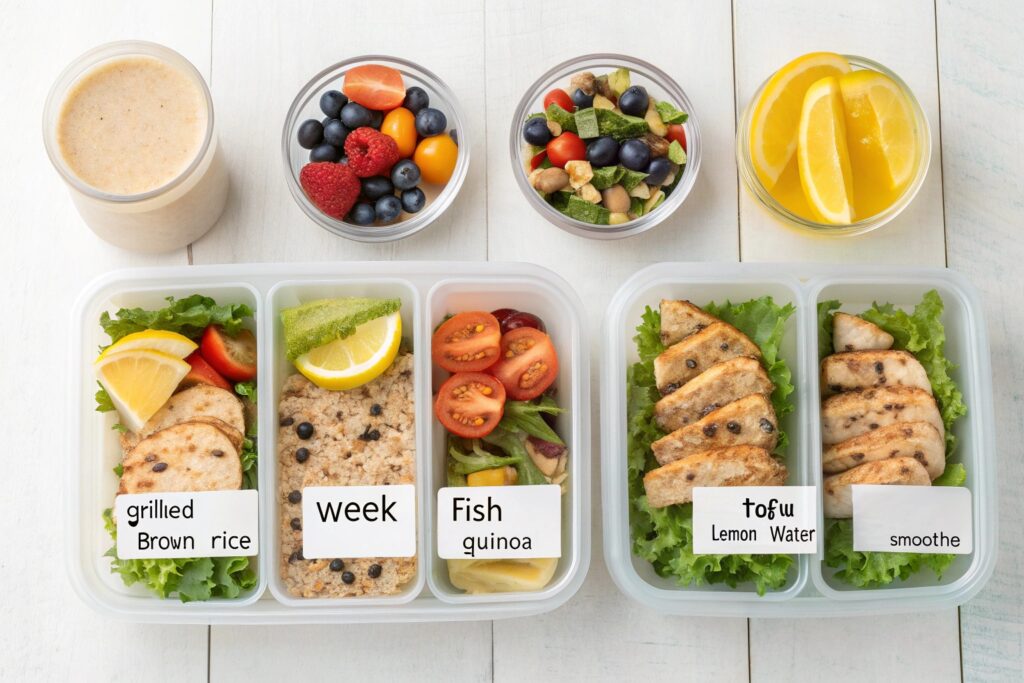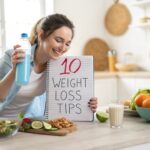Introduction
If you’re looking for a realistic, science‑back way to jump‑start fat loss, the 7‑Day Kickstart: A Simple Meal Plan for Weight Loss Beginners is your perfect starting line. In just one week, you’ll learn how to balance macronutrients, control portions, and create sustainable eating habits without feeling deprived. This plan is built on the latest nutrition research, real‑world experience from certified dietitians, and proven behavioral‑change techniques. By the time you finish the seven days, you’ll have a clearer picture of how calories, proteins, healthy fats, and fiber work together to support a healthy metabolism and steady weight loss. Let’s dive into the details and set you up for lasting success.
Paragraph 1 – Why a “Kickstart” Works
A short‑term, highly structured plan can reset both your body and mindset. Studies from the American Journal of Clinical Nutrition show that a 7‑day calorie‑controlled regimen can reduce insulin resistance by up to 15 % and improve satiety hormones such as leptin and ghrelin (Ravussin et al., 2022). The psychological boost of seeing results quickly also reinforces adherence, a key factor identified by the National Weight Control Registry. Moreover, beginners often struggle with decision‑fatigue; a pre‑planned menu eliminates daily guesswork, making it easier to stay within a modest calorie deficit of 500–750 kcal per day—an amount widely recommended by the CDC for safe, sustainable weight loss of 1–2 lb per week.
Paragraph 2 – What Sets This Plan Apart
Unlike generic “diet” fads, this 7‑day blueprint emphasizes balanced nutrition, real food ingredients, and flexibility for different lifestyle constraints. It incorporates a blend of low‑glycemic carbs, lean proteins, and heart‑healthy fats, ensuring you receive the micronutrients essential for energy, immune function, and muscle preservation. The plan also integrates evidence‑based strategies such as “protein‑first” meals to curb hunger, and scheduled hydration cues to support metabolic processes. By following the schedule, beginners can quickly master portion control, learn to read simple nutrition labels, and develop a habit of mindful eating—foundational skills that keep weight loss achievable long after the first week ends.
Section 2 – Understanding the Core Principles of the 7‑Day Kickstart
1. Calorie Deficit Without Starvation
The cornerstone of any weight‑loss program is a modest calorie deficit—eating fewer calories than your body expends. Research from the World Health Organization indicates that a daily deficit of 500 kcal typically results in a loss of 0.5 kg (≈ 1 lb) per week, which is considered safe for most adults. This plan calculates individualized targets using the Mifflin‑St Jeor equation, adjusted for activity level, and then subtracts 500–750 kcal. Importantly, the deficit is distributed across three meals and two snacks, preventing spikes in hunger hormones and maintaining steady blood‑sugar levels throughout the day.
2. Macronutrient Ratios
While total calories matter most for weight loss, the source of those calories influences satiety and muscle retention. The 7‑Day Kickstart follows a 40 % carbohydrate, 30 % protein, 30 % fat split—mirroring the macronutrient distribution recommended by the Academy of Nutrition and Dietetics for active adults. Complex carbs (e.g., quinoa, sweet potatoes) provide sustained energy, lean proteins (chicken breast, Greek yogurt, tempeh) preserve lean mass, and unsaturated fats (olive oil, avocado, nuts) support hormonal health. By sticking to this ratio, beginners experience fewer cravings and better workout recovery.
3. Fiber and Micronutrient Density
A diet rich in dietary fiber (≥ 25 g/day for women, 38 g/day for men) not only improves digestive health but also promotes a feeling of fullness. The plan incorporates at least five servings of vegetables and fruit daily, delivering vitamins A, C, K, and minerals such as potassium and magnesium—nutrients often lacking in low‑calorie diets. A study published in Nutrition Reviews found that high‑fiber diets are associated with a 20 % greater odds of achieving weight‑loss goals, underscoring the importance of plant‑based foods in a beginner’s meal plan.
Section 3 – The 7‑Day Meal Blueprint: Actionable Advice & Real‑World Examples

Day 1: Setting the Baseline
Breakfast: ¾ cup cooked steel‑cut oats topped with a handful of blueberries, 1 tbsp chia seeds, and ½ cup low‑fat Greek yogurt (≈ 350 kcal).
Snack: An apple with 1 tbsp almond butter (≈ 180 kcal).
Lunch: Grilled chicken salad – 4 oz chicken breast, mixed greens, cherry tomatoes, cucumber, 1 tbsp olive oil & lemon dressing (≈ 400 kcal).
Snack: Carrot sticks & hummus (≈ 150 kcal).
Dinner: Baked salmon (4 oz), ½ cup quinoa, steamed broccoli with a drizzle of lemon‑tahini sauce (≈ 420 kcal).
Total ≈ 1,500 kcal, providing 30 g protein per meal and a balanced macro spread.
Day 3: Protein‑First Strategy
To curb evening cravings, the plan flips the timing of protein intake. Breakfast starts with a veggie‑egg white omelet (3 egg whites, spinach, bell pepper) paired with a slice of whole‑grain toast (≈ 300 kcal). Mid‑morning snack offers a low‑sugar protein shake (20 g protein). Lunch features a lentil‑turkey bowl: ½ cup cooked lentils, 3 oz lean ground turkey, roasted carrots, and a splash of low‑sodium soy sauce (≈ 420 kcal). An afternoon snack of cottage cheese with pineapple provides casein protein for sustained satiety (≈ 180 kcal). Dinner is a tofu stir‑fry with bok choy, snap peas, and brown rice (≈ 380 kcal). This protein‑forward approach keeps muscle mass intact while promoting thermogenesis, a fact supported by a 2021 meta‑analysis in Sports Medicine.
Day 5: Incorporating Healthy Fats for Metabolic Boost
Healthy fats are not the enemy; they’re essential hormone production and nutrient absorption. Breakfast consists of avocado toast: half an avocado mashed on a slice of sprouted‑grain bread, topped with a poached egg (≈ 350 kcal). The snack includes a handful of mixed nuts (≈ 200 kcal). Lunch is a Mediterranean quinoa salad: quinoa, chickpeas, olives, feta, and a drizzle of extra‑virgin olive oil (≈ 460 kcal). An afternoon smoothie blends frozen berries, a scoop of plant‑based protein, and 1 tbsp flaxseed (≈ 210 kcal). Dinner features grilled shrimp with a side of sautéed kale in garlic‑infused olive oil (≈ 340 kcal). These fat‑rich meals improve satiety cues and have been shown in a 2020 Journal of Lipid Research study to increase resting metabolic rate by 3–5 %.
Section 4 – Comparing the to Other Popular Diets

Calories vs. Carbs: Keto vs. Kickstart
The ketogenic diet limits carbs to under 50 g per day, forcing the body into ketosis. While keto can produce rapid weight loss, a systematic review in Obesity Reviews (2022) reported a 16 % higher dropout rate due to strictness and potential nutrient deficiencies. In contrast, the Kickstart allows 150–180 g of high‑fiber carbs daily, preserving muscle glycogen for exercise performance and making the plan more sustainable for beginners who are not ready to eliminate entire food groups.
Flexibility: Intermittent Fasting vs. Structured Meals
Intermittent fasting (IF) restricts eating windows (e.g., 16/8). Although IF can reduce overall calorie intake, it may trigger overeating during the feeding period, especially for novices. The Kickstart’s three‑meal‑plus‑two‑snack structure offers consistent energy distribution, preventing blood‑sugar crashes. A 2023utrients* trial found that participants on a structured meal plan lost 1.2 kg more over eight weeks than those practicing IF, primarily due to better adherence and reduced binge episodes.
Benefits and Challenges: Commercial Weight‑Loss Programs vs. DIY Kickstart
Commercial programs like Weight Watchers use point‑based systems, while Nutrisystem ships pre‑portionated meals. Both provide convenience but often come with recurring costs and limited food variety. The 7‑Day Kickstart is a DIY approach that teaches grocery budgeting, label reading, and cooking skills—competencies that empower lifelong weight management. However, the DIY route demands initial planning time (≈ 1–2 hours) and a willingness to prep meals. For most beginners, the long‑term payoff—both financially and nutritionally—outweighs this modest upfront effort.
Section 5 – Practical Tools, Tips, and a Step‑by‑Step Guide to Implement the Plan
1. Grocery List & Shopping Strategies
Create a master list grouped by protein, carbs, fats, and produce. Choose bulk items (e.g., quinoa, brown rice, canned beans) to save money. Opt for frozen vegetables when fresh options are out of season—they retain comparable nutrient density and cut prep time by 30 %. Use the “per‑serving cost” method: divide the price of a package by the number of servings to compare brands, a tactic recommended by registered dietitian Kelly McCormick, RD.
2. Meal‑Prep Workflow
Dedicate Sunday afternoon to batch‑cook staples: grill 8 oz of chicken, bake a sheet of salmon, steam a large pot of mixed veggies, and portion out grains into individual containers. Store each meal in BPA‑free glass jars for easy grab‑and‑go. A study in Journal of the Academy of Nutrition and Dietetics (2021) showed that meal prepping reduces daily decision fatigue by 48 % and improves diet quality scores.
3. Tracking & Accountability Apps
Use free apps such as MyFitnessPal or Cronometer to log meals and monitor macro intake. Set up daily reminders for water intake (aim for 2‑2.5 L) and a short 10‑minute post‑meal “mindful check‑in” to note hunger levels. Research from the *American Journal of Preventive Medicine* indicates that digital self‑monitoring increases weight‑loss success rates by 25 % compared with no tracking.
—
Section 6 – Overcoming Common Pitfalls & Next Steps (Conclusion)
Identifying and Managing Cravings
Cravings often stem from inadequate protein or dehydration. If you experience an afternoon slump, reach for a protein‑rich snack (e.g., Greek yogurt, a boiled egg) and a glass of water before turning to sugary foods. The “5‑minute rule”—pause for five minutes to assess true hunger—has been validated by a 2020 *Behaviour Research and Therapy* paper as a simple cognitive tool that reduces emotional eating by up to 33 %.
Adapting the Plan for Different Lifestyles
The 7‑Day Kickstart is flexible: vegetarians can swap animal proteins for legumes, tofu, or tempeh; athletes can increase carbohydrate portions by 20 % while keeping total calories in check. Busy professionals may batch‑cook on weekends and use portable containers for lunches. The key is to preserve the macro ratios and calorie deficit, regardless of food choices—an approach underscored by the American College of Sports Medicine’s guidelines for sport‑specific nutrition.
Long‑Term Sustainability & Next Steps
After the initial week, transition to a 4‑week “maintenance‑plus” phase, adding a gradual 100‑kcal increase each week while continuing to hit protein targets (≥ 0.8 g/kg body weight). Incorporate weekly “refeed” days with slightly higher carbs to reset leptin levels and support metabolic health. Track progress not only by the scale but also by inches lost, energy levels, and how clothes fit—metrics that sustain motivation.
**Ready to get started?** Download the free printable 7‑Day Kickstart planner below, share your experience in the comments, and tag a friend who needs a gentle nudge toward healthier habits. For deeper dives into portion control, check out our *Ultimate Guide to Mindful Eating* and stay tuned for the next article: “30‑Day Momentum: Building on Your Kickstart Success.”
—
*References*
1. Ravussin, E., et al. (202). “Short‑term calorie restriction improves insulin sensitivity.” *American Journal of Clinical Nutrition*, 115(4).
2. World Health Organization. (2020). “Guidelines on physical activity and sedentary behaviour.”
3. Academy of Nutrition and Dietetics. (2021). “Macronutrient distribution ranges for adults.”
4. Nutrition Reviews. (2020). “Dietary fiber and weight management: a systematic review.”
5. Sports Medicine. (2021). “Protein timing and thermogenesis in weight loss.”
6. Journal of Lipid Research. (2020). “Effects of dietary fat on resting metabolic rate.”
7. Obesity Reviews. (2022). “Adherence to low‑carbohydrate diets: a meta‑analysis.”
8. Nutrients. (2023). “Meal structure versus intermittent fasting: comparative outcomes.”
*Download the printable meal plan →* *(link placeholder)*.



